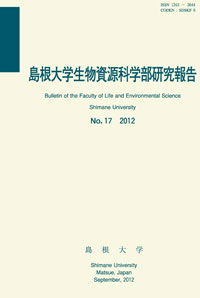島根大学生物資源科学部
ISSN:2435-0885(online)
ISSN:1343-3644(in print)
A publication of this bulletin in print format has not been made since no 24.
ISSN:1343-3644(in print)
A publication of this bulletin in print format has not been made since no 24.

number of downloads : ?
Use this link to cite this item : https://ir.lib.shimane-u.ac.jp/5650
Bulletin of the Faculty of Life and Environmental Science Shimane University 9
2004-08-31 発行
魚類の水晶体筋収縮に関与するムスカリン性受容体サブタイプの生理学的検討
A pharmacological study of the muscarinic receptors mediating the contraction of teleost lens muscle
Fujimoto, Masaaki
Suyama, Mayumi
Yamamoto, Junji
File
Description
The teleost uses a lens muscle, the retractor lentis, for accommodation to change the distance between the lens and retina. It is innervated by the parasympathetic nerve and regulated with a muscarinic cholinergic receptor. However, the receptor subtype mediating the muscarinic contraction is unknown. In the present work, we examined the subtype in the receptor of the bluegill (Lepomis macrochirus) lens muscle. The enucleated eye was hemisected and the anterior segment was set in a perfusing chamber equipped with two Ag/AgCl electrodes for electrical stimulation. The image of contraction of the lens muscle was displayed on a video screen with a CCD camera via a binocular microscope and simultaneously stored on tape. The degree of contraction was measured directly on the display.
We tested the effect of adiphenine or pirenzepine (M1 subtype antagonists) , gallamine (M2 subtype antagonist) and 4-DAMP (M3 subtype antagonist) on the contraction elicited by carbachol (a nonselective agonist) or electrical stimulation of the nerve in vitro. The muscle contraction was elicited by carbachol or inhibited by these antagonists in a dose-dependent manner. Among the inhibitors, 4-DAMP was the most potent, while the other two antagonists showed about 10-fold weaker effects. From these results, we concluded that the subtype of the muscarinic receptor mediating the contraction of the bluegill lens muscle is M3. The mammalian ciliary muscle has also been reported to have the M3 receptor. It is intriguing that the homologous organ for accommodation both in the mammals and in teleosts has the same muscarinic receptor subtype.
We tested the effect of adiphenine or pirenzepine (M1 subtype antagonists) , gallamine (M2 subtype antagonist) and 4-DAMP (M3 subtype antagonist) on the contraction elicited by carbachol (a nonselective agonist) or electrical stimulation of the nerve in vitro. The muscle contraction was elicited by carbachol or inhibited by these antagonists in a dose-dependent manner. Among the inhibitors, 4-DAMP was the most potent, while the other two antagonists showed about 10-fold weaker effects. From these results, we concluded that the subtype of the muscarinic receptor mediating the contraction of the bluegill lens muscle is M3. The mammalian ciliary muscle has also been reported to have the M3 receptor. It is intriguing that the homologous organ for accommodation both in the mammals and in teleosts has the same muscarinic receptor subtype.
About This Article
Other Article
PP. 13 - 21
PP. 41 - 49
